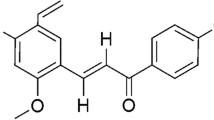Abstract
Betulin, an abundant natural compound, significantly inhibited the cell viability of advanced human gastric cancer SGC7901 cells. Mechanism study demonstrated that betulin induced apoptosis through mitochondrial Bax and Bak accumulation-mediated intrinsic apoptosis pathway. Downregulation of the anti-apoptosis proteins Bcl-2 and XIAP was involved during betulin-induced cell apoptosis. Reactive oxygen species (ROS) was generated in cells after betulin treatment in a time- and dose-dependent manner. Addition of antioxidant N-acetyl-l-cysteine (NAC) significantly attenuated betulin-induced ROS generation as well as Bcl-2 and XIAP downregulation. The mitochondrial accumulation of Bax and Bak, as well as caspase activity, was also remarkably inhibited by NAC treatment, indicating that ROS are important signaling intermediates that lead to betulin-induced apoptosis by modulating multiple apoptosis-regulating proteins in SGC7901 cells.







Similar content being viewed by others
References
Amin AR, Kucuk O, Khuri FR, Shin DM (2009) Perspectives for cancer prevention with natural compounds. J Clin Oncol 27:2712–2725
Azad N, Iyer A, Vallyathan V, Wang L, Castranova V, Stehlik C, Rojanasakul Y (2010) Role of oxidative/nitrosative stress-mediated Bcl-2 regulation in apoptosis and malignant transformation. Ann NY Acad Sci 1203:1–6
Chipuk JE, Green DR (2008) How do BCL-2 proteins induce mitochondrial outer membrane permeabilization? Trends Cell Biol 18:157–164
Davis W Jr, Ronai Z, Tew KD (2001) Cellular thiols and reactive oxygen species in drug-induced apoptosis. J Pharmacol Exp Ther 296:1–6
Du C, Fang M, Li Y, Li L, Wang X (2000) Smac, a mitochondrial protein that promotes cytochrome c-dependent caspase activation by eliminating IAP inhibition. Cell 102:33–42
Hartgrink HH, Jansen EP, Van Grieken NC, Van D, Velde CJ (2009) Gastric cancer. Lancet 374:477–490
Hengartner MO (2000) The biochemistry of apoptosis. Nature 407:770–776
Kane DJ, Sarafian TA, Anton R, Hahn H, Gralla EB, Valentine JS, Ord T, Bredesen DE (1993) Bcl-2 inhibition of neural death: decreased generation of reactive oxygen species. Science 262:1274–1277
Kilbride SM, Prehn JH (2013) Central roles of apoptotic proteins in mitochondrial function. Oncogene 32:2703–2711
Kirkin V, Joos S, Zornig M (2004) The role of Bcl-2 family members in tumorigenesis. Biochim Biophys Acta 1644:229–249
Krasutsky PA (2006) Birch bark research and development. Nat Prod Rep 23:919–942
Li Y, He K, Huang Y, Zheng D, Gao C, Cui L, Jin YH (2010a) Betulin induces mitochondrial cytochrome c release associated apoptosis in human cancer cells. Mol Carcinog 49:630–640
Li Y, Shen JT, Gao C, Li Q, Jin YH (2010b) Caspase-9 activation-critical for betulin-induced apoptosis of human hepatoma cells. Chem Res Chin Univ 26:792–797
Lopes RA, Neves KB, Pestana CR, Queiroz AL, Zanotto CZ, Chignalia AZ, Valim YM, Silveira LR, Curti C, Tostes RC (2014) Testosterone induces apoptosis in vascular smooth muscle cells via extrinsic apoptotic pathway with mitochondria-generated reactive oxygen species involvement. Am J Physiol Heart Circ Physiol 306:H1485–H1494
Rzeski W, Stepulak A, Szymanski M, Juszczak M, Grabarska A, Sifringer M, Kaczor J, Kandefer-Szerszen M (2009) Betulin elicits anti-cancer effects in tumour primary cultures and cell lines in vitro. Basic Clin Pharmacol Toxicol 105:425–432
Shi YH, Ding WX, Zhou J, He JY, Xu Y, Gambotto AA, Rabinowich H, Fan J, Yin XM (2008) Expression of X-linked inhibitor-of-apoptosis protein in hepatocellular carcinoma promotes metastasis and tumor recurrence. Hepatology 48:497–507
Siegel R, Naishadham D, Jemal A (2013) Cancer statistics, 2013. CA Cancer J Clin 63:11–30
Simon HU, Haj-Yehia A, Levi-Schaffer F (2000) Role of reactive oxygen species (ROS) in apoptosis induction. Apoptosis 5:415–418
Smyth EC, Cunningham D (2012) Targeted therapy for gastric cancer. Curr Treat Options Oncol 13:377–389
Susnow N, Zeng L, Margineantu D, Hockenbery DM (2009) Bcl-2 family proteins as regulators of oxidative stress. Semin Cancer Biol 19:42–49
Takahashi T, Saikawa Y, Fukuda K, Wada N, Kawakubo H, Takeuchi H, Fukada J, Kawaguchi O, Takaishi H, Shigematsu N, Kitagawa Y (2012) Chemoradiotherapy for advanced gastric cancer. Gan To Kagaku Ryoho 39:2464–2468
Tang JJ, Li JG, Qi W, Qiu WW, Li PS, Li BL, Song BL (2011) Inhibition of SREBP by a small molecule, betulin, improves hyperlipidemia and insulin resistance and reduces atherosclerotic plaques. Cell Metab 13:44–56
Van Loo G, Saelens X, Van Gurp M, Macfarlane M, Martin SJ, Vandenabeele P (2002) The role of mitochondrial factors in apoptosis: a Russian roulette with more than one bullet. Cell Death Differ 9:1031–1042
Westphal D, Dewson G, Czabotar PE, Kluck RM (2011) Molecular biology of Bax and Bak activation and action. Biochim Biophys Acta 1813:521–531
Zorov DB, Juhaszova M, Sollott SJ (2006) Mitochondrial ROS-induced ROS release: an update and review. Biochim Biophys Acta 1757:509–517
Acknowledgments
This study was funded by Grant from the Nature Science Foundation of China (Project 31240078), and Grant of Talent Exploitation in 2012 from Jilin Province.
Author information
Authors and Affiliations
Corresponding authors
Ethics declarations
Conflict of Interest
The authors declare no conflict of interest.
Rights and permissions
About this article
Cite this article
Li, Y., Liu, X., Jiang, D. et al. Betulin induces reactive oxygen species-dependent apoptosis in human gastric cancer SGC7901 cells. Arch. Pharm. Res. 39, 1257–1265 (2016). https://doi.org/10.1007/s12272-016-0761-5
Received:
Accepted:
Published:
Issue Date:
DOI: https://doi.org/10.1007/s12272-016-0761-5




